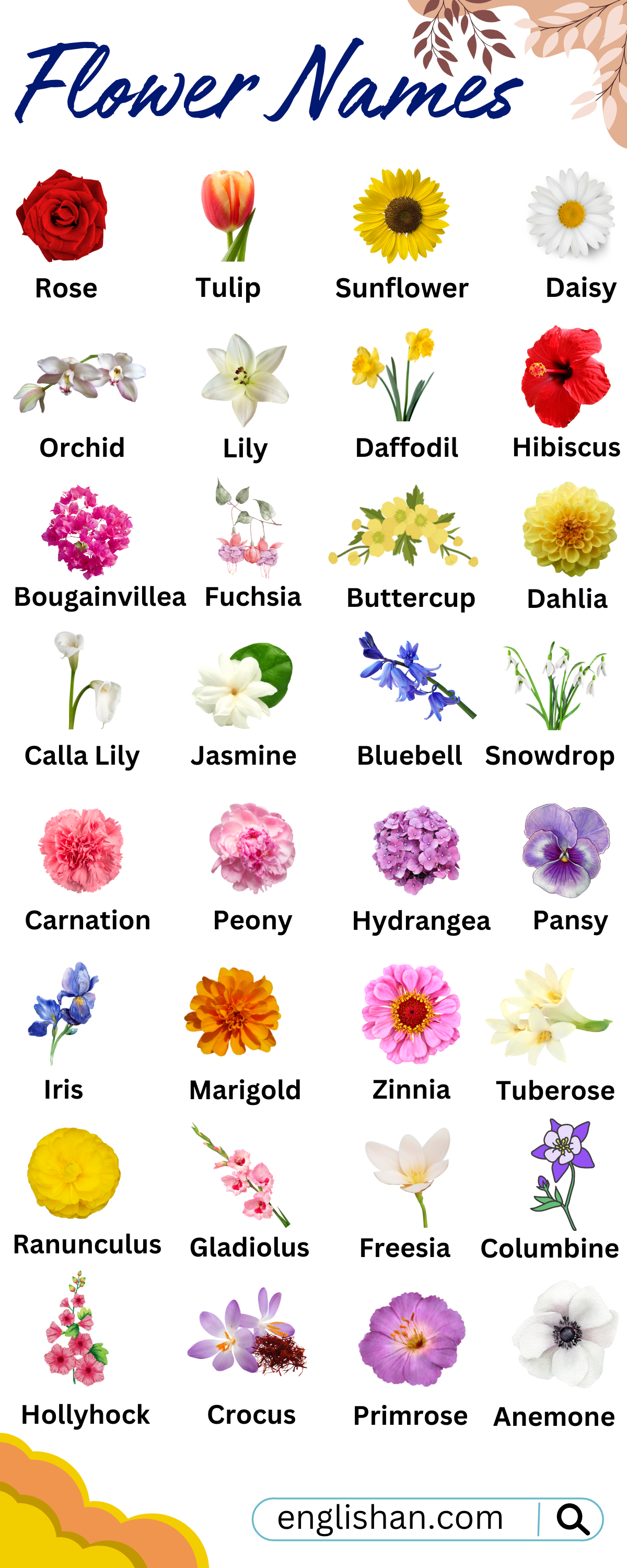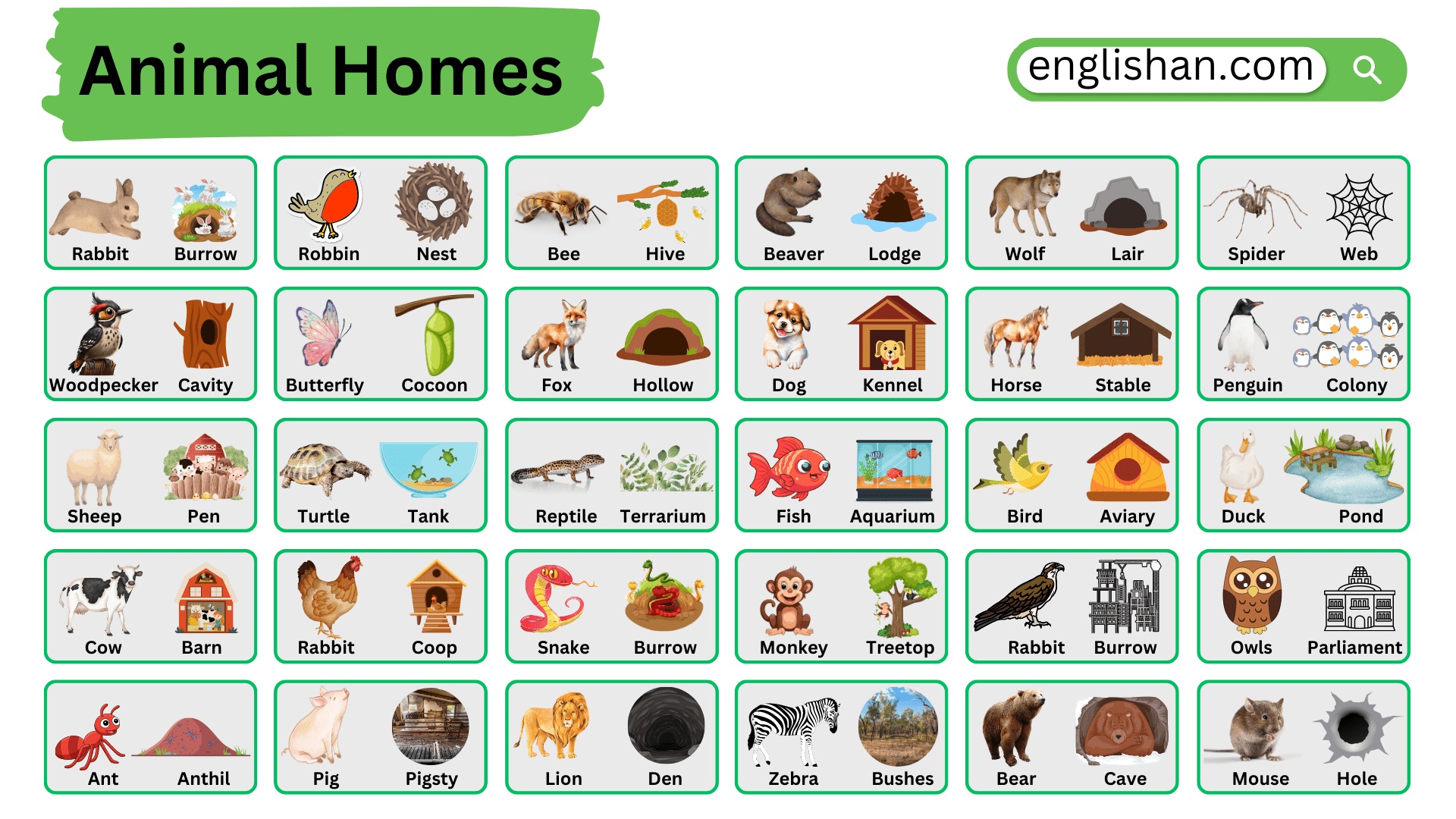Contents
In this blog post, you will learn the names of different flowers in English. This will help you understand how to identify and talk about various flowers in everyday conversations. Knowing these names can improve your vocabulary and make it easier to describe flowers in English. By connecting words with images, you can master these terms and use them confidently. To expand your vocabulary on more topics, visit our Vocabulary Category.
Flowers Names in English
Spring Blooming Flowers
Tulip
Tulips are vibrant, iconic flowers that are a springtime favorite. They come in various colors and brighten up gardens everywhere.
- Color: Red, yellow, pink, white
- Fragrance: Mild
- Blooming Season: Spring
- Lifespan: Perennial (often treated as annuals)
Crocus
Crocuses are among the first flowers to bloom in spring, often peeking through the snow with their delicate petals.
- Color: Purple, yellow, white
- Fragrance: Mild
- Blooming Season: Early Spring
- Lifespan: Perennial
Cherry Blossom
Cherry Blossoms are breathtaking flowers that symbolize renewal. Their soft pink petals create stunning landscapes during the spring season. These flowers names are celebrated worldwide for their beauty.
- Color: Pink, white
- Fragrance: Mild
- Blooming Season: Spring
- Lifespan: Perennial
Snowdrop
Snowdrops are small, bell-shaped flowers that signal the end of winter. Their white petals symbolize hope and purity.
- Color: White
- Fragrance: Mild
- Blooming Season: Late Winter to Early Spring
- Lifespan: Perennial
Magnolia
Magnolias are large, fragrant flowers that bloom in early spring. Their size and beauty make them a standout in gardens.
- Color: White, pink, purple
- Fragrance: Strong
- Blooming Season: Spring
- Lifespan: Perennial
Daffodil
Daffodils are cheerful spring flowers with bright yellow petals. Their trumpet-shaped blooms are a classic sign of the season. These flowers names are synonymous with springtime joy.
- Color: Yellow, white
- Fragrance: Mild
- Blooming Season: Early Spring
- Lifespan: Perennial
Hyacinth
Hyacinths are spring flowers known for their rich fragrance and dense, colorful clusters. They add beauty and scent to any garden.
- Color: Blue, purple, pink, white
- Fragrance: Strong
- Blooming Season: Spring
- Lifespan: Perennial
Lilac
Lilacs are beloved for their sweet fragrance and clusters of small flowers. They are a popular choice for spring gardens.
- Color: Purple, white, pink
- Fragrance: Strong
- Blooming Season: Late Spring
- Lifespan: Perennial
Primrose
Primroses are early bloomers, appearing in vibrant colors. They bring life to gardens as winter fades away, making them perfect for spring landscapes.
- Color: Yellow, pink, purple, red
- Fragrance: Mild
- Blooming Season: Early Spring
- Lifespan: Perennial
Forsythia
Forsythias are bright, yellow-flowering shrubs that signal the arrival of spring. Their golden blooms are among the first to appear.
- Color: Yellow
- Fragrance: None
- Blooming Season: Early Spring
- Lifespan: Perennial
Anemone
Anemones are delicate spring flowers that add a pop of color to gardens. Their daisy-like appearance is loved by many.
- Color: White, pink, purple, red
- Fragrance: Mild
- Blooming Season: Spring
- Lifespan: Perennial
Peony
Peonies are large, lush flowers that bloom in late spring. Their fragrant blossoms are often associated with romance and luxury. These flowers names are perfect for elegant gardens.
- Color: Pink, white, red
- Fragrance: Strong
- Lifespan: Perennial
Ranunculus
Ranunculus flowers are known for their layers of delicate petals and vibrant colors. They are popular in both gardens and floral arrangements.
- Color: Pink, yellow, red, white
- Fragrance: Mild
- Blooming Season: Spring
- Lifespan: Annual
Violet
Violets are charming, small flowers that bring elegance to spring gardens. Their heart-shaped leaves and vibrant petals make them a favorite.
- Color: Purple, blue, white
- Fragrance: Sweet
- Blooming Season: Spring
- Lifespan: Perennial
Azalea
Azaleas are popular shrubs that burst into bloom in spring, covering themselves with vibrant flowers. These flowers names are loved for their colorful display.
- Color: Pink, red, white, purple
- Fragrance: Mild
- Blooming Season: Spring
- Lifespan: Perennial
Bluebell
Bluebells are enchanting spring flowers that form beautiful carpets of blue in woodlands and gardens. They are known for their nodding flowers.
- Color: Blue, purple
- Fragrance: Sweet
- Blooming Season: Spring
- Lifespan: Perennial
Camellia
Camellias are stunning spring flowers with large, glossy petals. These blooms are often associated with luxury and grace. These flowers names are known for their early spring beauty.
- Color: Pink, red, white
- Fragrance: Mild
- Blooming Season: Late Winter to Spring
- Lifespan: Perennial
Rhododendron
Rhododendrons are large, showy shrubs that produce clusters of vibrant flowers in spring. They are loved for their bright colors and lush foliage.
- Color: Purple, pink, red, white
- Fragrance: Mild
- Blooming Season: Spring
- Lifespan: Perennial
Poppy
Poppies are delicate flowers that bloom in spring and summer. They are easily recognizable by their bright, paper-like petals and central seed pod. These flowers names are often associated with remembrance.
- Color: Red, orange, pink, white
- Fragrance: None
- Blooming Season: Spring to Early Summer
- Lifespan: Annual or Perennial (depending on species)
Azalea
Azaleas are popular shrubs that burst into bloom in spring, covering themselves with vibrant flowers. These flowers names are well-loved for their colorful display.
- Color: Pink, red, white, purple
- Fragrance: Mild
- Blooming Season: Spring
- Lifespan: Perennial
Spring Flowers with Pictures
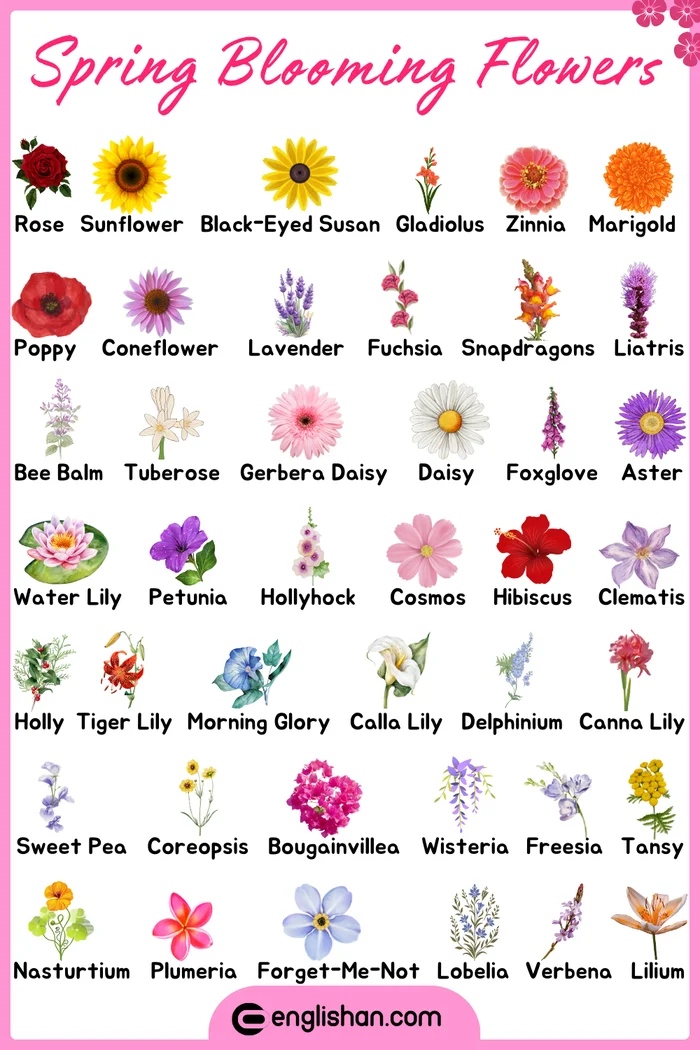
Summer Blooming Flowers Names
Rose
Roses are classic flowers known for their beauty and fragrance. They bloom throughout the summer and are a symbol of love and elegance.
- Color: Red, pink, yellow, white
- Fragrance: Strong
- Lifespan: Perennial
Sunflower
Sunflowers are tall, bright flowers that are iconic in the summer. They are known for their large, sun-like appearance and can grow to impressive heights.
- Color: Yellow
- Fragrance: None
- Blooming Season: Summer
- Maintenance Level: Low
- Lifespan: Annual
Daisy
Daisies are cheerful summer flowers with simple, white petals surrounding a yellow center. They are a symbol of purity and innocence, often seen in wild meadows.
- Color: White, yellow
- Fragrance: Mild
- Blooming Season: Summer
- Maintenance Level: Low
- Lifespan: Perennial
Gladiolus
Gladiolus flowers are tall and striking, blooming in mid to late summer. They produce spikes of large, colorful flowers and are popular in bouquets. These flowers names are often linked with strength and integrity.
- Color: Red, pink, yellow, white
- Fragrance: Mild
- Blooming Season: Summer
- Maintenance Level: Moderate
- Lifespan: Perennial
Delphinium
Delphiniums are tall, elegant flowers with spikes of blue, purple, pink, or white blooms. They add height and a touch of grace to summer gardens. These flowers names are often associated with elegance and charm.
- Color: Blue, purple, pink, white
- Fragrance: Mild
- Blooming Season: Summer
- Maintenance Level: Moderate
- Lifespan: Perennial
Foxglove
Foxgloves are striking summer flowers with tall spikes of tubular blooms. They are known for their bold colors and are often used to add vertical interest in gardens.
- Color: Pink, purple, white
- Fragrance: None
- Blooming Season: Summer
- Maintenance Level: Moderate
- Lifespan: Biennial
Aster
Asters are daisy-like flowers that bloom in late summer and fall. They are known for their star-shaped blooms and vibrant colors, making them a favorite in many gardens.
- Color: Purple, pink, white, blue
- Fragrance: Mild
- Blooming Season: Late Summer to Fall
- Maintenance Level: Low
- Lifespan: Perennial
Water Lily
Water Lilies are stunning aquatic flowers that bloom in ponds and water gardens. Their large, floating blooms are a symbol of peace and serenity. These flowers names are well-loved for their beauty in water features.
- Color: White, pink, yellow
- Fragrance: Mild
- Blooming Season: Summer
- Maintenance Level: Moderate
- Lifespan: Perennial
Tuberose
Tuberoses are highly fragrant flowers that bloom in late summer. They are often used in perfumes and have a rich, sweet scent that fills the garden.
- Color: White
- Fragrance: Strong
- Blooming Season: Late Summer
- Maintenance Level: Moderate
- Lifespan: Perennial
Hibiscus
Hibiscus flowers are large, showy blooms that thrive in the summer heat. They are known for their tropical appearance and are often used in warm climates.
- Color: Red, pink, yellow, white
- Fragrance: Mild
- Blooming Season: Summer
- Maintenance Level: Low
- Lifespan: Perennial
Bougainvillea
Bougainvilleas are vibrant, climbing plants that produce a stunning display of color throughout the summer. They are perfect for adding a splash of color to walls and trellises.
- Color: Pink, purple, red, orange
- Fragrance: None
- Blooming Season: Summer
- Maintenance Level: Low
- Lifespan: Perennial
Clematis
Clematis is a popular climbing plant with beautiful, star-shaped flowers that bloom in the summer. It’s often grown on trellises or fences for its decorative appeal.
- Color: Purple, pink, white, blue
- Fragrance: Mild
- Blooming Season: Summer
- Maintenance Level: Moderate
- Lifespan: Perennial
Cosmos
Cosmos are easy-to-grow summer flowers that produce a profusion of blooms in bright, cheerful colors. They are perfect for wildflower gardens and attract butterflies.
- Color: Pink, red, white, orange
- Fragrance: Mild
- Blooming Season: Summer
- Maintenance Level: Low
- Lifespan: Annual
Holly
Holly is a hardy plant known for its glossy green leaves and bright red berries. Although it’s more famous for its winter display, some holly varieties bloom in the summer. These flowers names are often associated with festive cheer.
- Color: White
- Fragrance: None
- Blooming Season: Summer
- Maintenance Level: Low
- Lifespan: Perennial
Tiger Lily
Tiger Lilies are bold, orange flowers with dark spots that bloom in the summer. They are known for their striking appearance and are a favorite among gardeners.
- Color: Orange with dark spots
- Fragrance: Mild
- Blooming Season: Summer
- Maintenance Level: Low
- Lifespan: Perennial
Calla Lily
Calla Lilies are elegant summer flowers with trumpet-shaped blooms. They are often used in floral arrangements and weddings for their sophisticated look.
- Color: White, pink, yellow, purple
- Fragrance: Mild
- Blooming Season: Summer
- Maintenance Level: Moderate
- Lifespan: Perennial
Canna Lily
Canna Lilies are bold, tropical-looking flowers that bloom in the summer. Their large, colorful blooms and striking foliage make them a popular choice for garden beds and containers.
- Color: Red, orange, yellow, pink
- Fragrance: None
- Blooming Season: Summer
- Maintenance Level: Moderate
- Lifespan: Perennial
Sweet Pea
Sweet Peas are fragrant, climbing flowers that bloom in the summer. They are known for their sweet scent and delicate, ruffled petals.
- Color: Pink, purple, white, red
- Fragrance: Strong
- Blooming Season: Summer
- Maintenance Level: Moderate
- Lifespan: Annual
Plumeria
Plumerias are tropical flowers known for their fragrant, star-shaped blooms. They are often used in making leis and add a touch of the tropics to gardens. These flowers names are synonymous with tropical beauty and fragrance.
- Color: White, yellow, pink, red
- Fragrance: Strong
- Blooming Season: Summer
- Maintenance Level: Low
- Lifespan: Perennial
Wisteria
Wisteria is a stunning, climbing plant that produces cascading clusters of fragrant flowers. It’s a popular choice for arbors and pergolas, adding a touch of elegance to summer gardens.
- Color: Purple, white, blue
- Fragrance: Mild
- Blooming Season: Late Spring to Summer
- Maintenance Level: Moderate
- Lifespan: Perennial
Freesia
Freesias are beloved for their sweet fragrance and vibrant blooms. These summer flowers are often used in bouquets and floral arrangements, known for their elegant appearance.
- Color: White, yellow, pink, purple
- Fragrance: Strong
- Blooming Season: Summer
- Maintenance Level: Moderate
- Lifespan: Perennial
Forget-Me-Not
Forget-Me-Nots are small, charming flowers with clusters of delicate blue blooms. They are often associated with remembrance and loyalty, blooming beautifully in the summer.
- Color: Blue, pink, white
- Fragrance: Mild
- Blooming Season: Spring to Summer
- Lifespan: Perennial
Tansy
Tansy is a hardy, summer-blooming plant with clusters of small, yellow flowers. It is often grown for its medicinal properties and as a natural insect repellent.
- Color: Yellow
- Fragrance: Mild
- Lifespan: Perennial
Nasturtium
Nasturtiums are vibrant, easy-to-grow summer flowers that add a splash of color to gardens. They are known for their edible leaves and flowers, which are often used in salads.
- Color: Red, orange, yellow
- Fragrance: Mild, peppery
- Lifespan: Annual
Coreopsis
Coreopsis are cheerful summer flowers that bloom in bright, sunny shades. They are drought-tolerant and attract butterflies, making them a great choice for low-maintenance gardens. These flowers names are often associated with sunny landscapes.
- Color: Yellow, orange, red
- Fragrance: None
- Lifespan: Perennial
Lobelia
Lobelias are delicate summer flowers with clusters of small, tubular blooms. They are often used in hanging baskets and containers, adding a pop of color to any space.
- Color: Blue, purple, white
- Fragrance: None
- Blooming Season: Summer
- Lifespan: Annual or Perennial
Verbena
Verbenas are long-blooming summer flowers that produce clusters of small, colorful blooms. They are perfect for adding color to garden borders and containers.
- Color: Pink, purple, red, white
- Fragrance: Mild
- Blooming Season: Summer
- Maintenance Level: Low
- Lifespan: Annual or Perennial (depending on variety)
Lilium
Lilies are elegant summer flowers known for their large, trumpet-shaped blooms. They come in various colors and are often associated with purity and beauty.
- Color: White, pink, orange, yellow
- Fragrance: Strong
- Blooming Season: Summer
- Maintenance Level: Moderate
- Lifespan: Perennial
Sweet Pea
Sweet Peas are fragrant, climbing flowers that bloom in the summer. They are known for their sweet scent and delicate, ruffled petals.
- Color: Pink, purple, white, red
- Fragrance: Strong
- Blooming Season: Summer
- Lifespan: Annual
Calla Lily
Calla Lilies are elegant summer flowers with trumpet-shaped blooms. They are often used in floral arrangements and weddings for their sophisticated look.
- Color: White, pink, yellow, purple
- Fragrance: Mild
- Blooming Season: Summer
- Lifespan: Perennial
Summer Flowers Names with Pictures
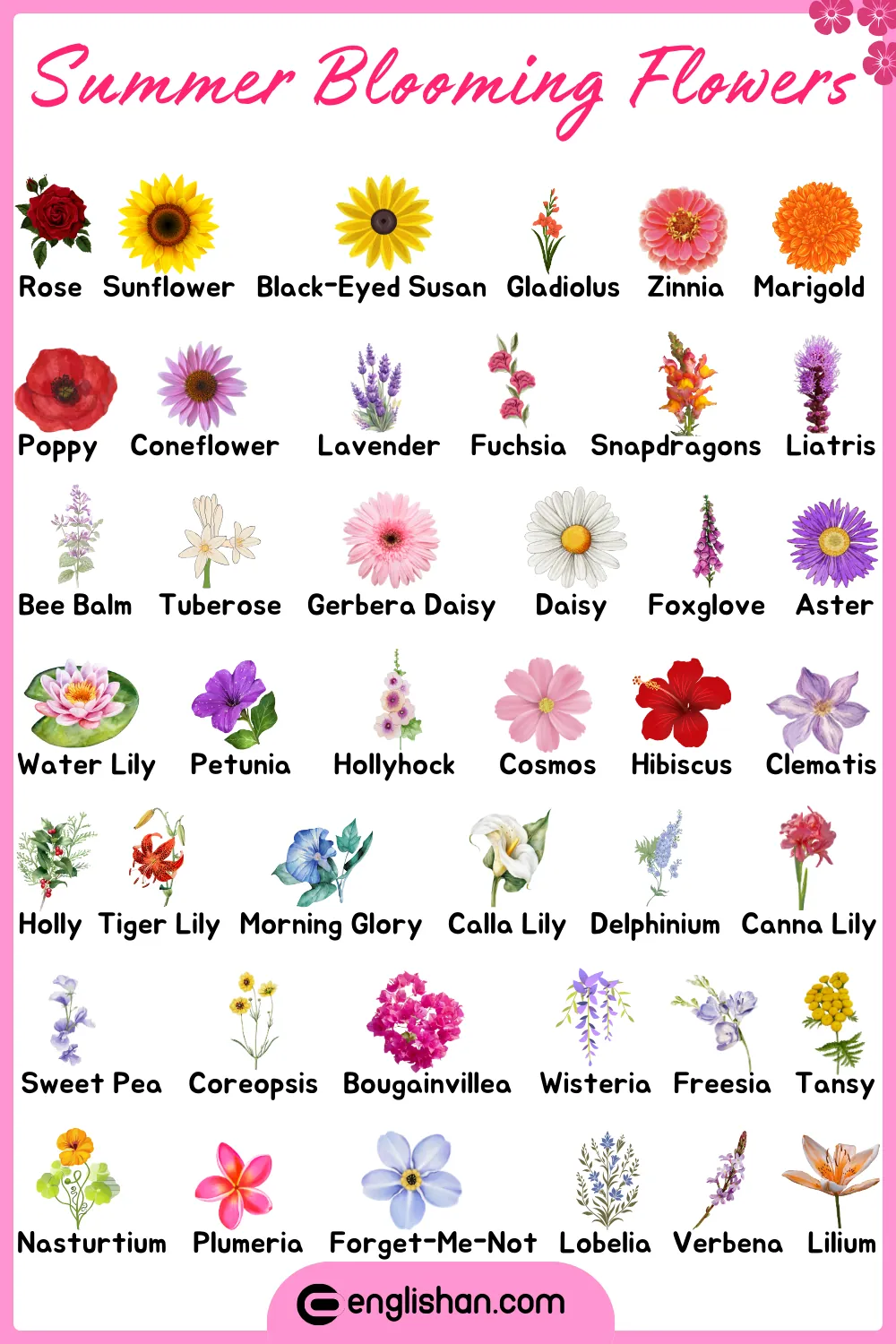
Fall Blooming Flowers Names
Chrysanthemum
Chrysanthemums, often referred to as mums, are popular fall flowers that come in a wide range of colors. They are known for their vibrant blooms that brighten up gardens as the weather cools. These flowers names are synonymous with autumn beauty.
- Color: Yellow, red, white, purple, orange
- Fragrance: Mild
- Blooming Season: Fall
- Lifespan: Perennial
Aster
Asters are star-shaped flowers that bloom in late summer and fall. They are known for their vibrant colors and ability to attract pollinators, making them a favorite in many fall gardens.
- Color: Purple, pink, white, blue
- Fragrance: Mild
- Blooming Season: Late Summer to Fall
- Lifespan: Perennial
Tithonia
Tithonias, also known as Mexican sunflowers, are bold, orange flowers that bloom in the fall. They are known for their ability to attract butterflies and add a splash of color to autumn gardens.
- Color: Orange, red
- Fragrance: None
- Blooming Season: Fall
- Lifespan: Annual
Sedum
Sedums are hardy succulents that produce clusters of tiny flowers in late summer and fall. They are drought-tolerant and perfect for rock gardens or low-maintenance landscapes. These flowers names are associated with resilience and adaptability.
- Color: Pink, red, white, yellow
- Fragrance: Mild
- Blooming Season: Late Summer to Fall
- Lifespan: Perennial
Goldenrod
Goldenrods are tall, yellow flowers that bloom in late summer and fall. They are often found in meadows and along roadsides, adding a touch of gold to the landscape.
- Color: Yellow
- Fragrance: None
- Blooming Season: Late Summer to Fall
- Lifespan: Perennial
Helenium
Heleniums, also known as sneezeweed, are cheerful fall flowers with daisy-like blooms. They are known for their bright colors and ability to thrive in late-season gardens.
- Color: Red, orange, yellow
- Fragrance: Mild
- Blooming Season: Fall
- Lifespan: Perennial
Japanese Anemone
Japanese Anemones are graceful fall flowers that bloom with delicate, cup-shaped petals. They are often found in shades of pink and white, adding a soft touch to autumn gardens.
- Color: Pink, white
- Fragrance: Mild
- Blooming Season: Late Summer to Fall
- Lifespan: Perennial
Saffron Crocus
Saffron Crocuses are unique fall-blooming flowers known for their vibrant purple petals and the precious saffron spice they produce. These flowers names are linked to luxury and culinary uses.
- Color: Purple
- Fragrance: Mild
- Blooming Season: Fall
- Lifespan: Perennial
Dahlia
Dahlias are showy flowers that bloom from midsummer to fall. They are known for their large, vibrant blooms that come in a wide range of colors and sizes, making them a favorite in flower arrangements.
- Color: Red, pink, yellow, orange, white
- Fragrance: Mild
- Blooming Season: Summer to Fall
- Lifespan: Perennial
Marigold
Marigolds are hardy flowers that bloom throughout the fall. Their bright, warm colors and distinctive scent make them a garden staple. These flowers names are often associated with autumn festivals.
- Color: Orange, yellow, red
- Fragrance: Strong, spicy
- Blooming Season: Fall
- Lifespan: Annual
Rudbeckia
Rudbeckias, also known as black-eyed Susans, are cheerful, hardy flowers that bloom in late summer and fall. They have bright yellow petals and dark centers, making them a standout in any garden.
- Color: Yellow with brown center
- Fragrance: None
- Blooming Season: Late Summer to Fall
- Lifespan: Perennial
Heliopsis
Heliopsis, also known as false sunflowers, are bright, daisy-like flowers that bloom from midsummer to fall. They are known for their long blooming period and ability to attract pollinators.
- Color: Yellow, orange
- Fragrance: Mild
- Blooming Season: Summer to Fall
- Lifespan: Perennial
Balloon Flower
Balloon Flowers are unique fall-blooming flowers with balloon-shaped buds that open into star-shaped blooms. They are known for their long-lasting beauty in gardens and bouquets. These flowers names are often associated with whimsical charm.
- Color: Blue, pink, white
- Fragrance: Mild
- Blooming Season: Summer to Fall
- Lifespan: Perennial
Cyclamen
Cyclamens are delicate fall flowers with heart-shaped leaves and bright, butterfly-like blooms. They are often grown as houseplants or in shaded garden beds.
- Color: Pink, red, white
- Fragrance: Mild
- Blooming Season: Fall
- Lifespan: Perennial
Verbena
Verbenas are long-blooming flowers that add vibrant color to fall gardens. Their small, clustered blooms are perfect for borders and containers.
- Color: Pink, purple, red, white
- Fragrance: Mild
- Blooming Season: Late Summer to Fall
- Lifespan: Perennial
Statice
Statices are popular fall flowers known for their papery, long-lasting blooms. They are often used in dried flower arrangements due to their durability.
- Color: Purple, blue, white, pink
- Fragrance: Mild
- Blooming Season: Fall
- Lifespan: Perennial
Calendula
Calendulas, also known as pot marigolds, are bright, cheerful flowers that bloom well into the fall. They are valued for their medicinal properties and vibrant color.
- Color: Yellow, orange
- Fragrance: Mild
- Blooming Season: Fall
- Lifespan: Annual
Yarrow
Yarrows are hardy, drought-resistant flowers that produce clusters of tiny blooms in fall. They are often grown for their medicinal properties and ability to attract pollinators.
- Color: Yellow, white, pink, red
- Fragrance: Mild
- Blooming Season: Summer to Fall
- Lifespan: Perennial
Coreopsis
Coreopsis are vibrant flowers that bring bright, sunny colors to fall gardens. They are easy to grow and are known for their long blooming period, making them a great choice for autumn landscapes.
- Color: Yellow, orange, red
- Fragrance: None
- Blooming Season: Summer to Fall
- Lifespan: Perennial
Poinsettia
Poinsettias are widely recognized as Christmas plants, but they also bloom in late fall. Their bright red, white, or pink bracts make them a popular choice for holiday decorations.
- Color: Red, pink, white
- Fragrance: None
- Blooming Season: Late Fall to Winter
- Maintenance Level: Moderate
- Lifespan: Perennial (often treated as annual)
Nasturtium
Nasturtiums are easy-to-grow fall flowers that add a splash of color to gardens. They are known for their edible leaves and flowers, which are often used in salads. These flowers names are popular for their versatility in the kitchen and garden.
- Color: Red, orange, yellow
- Fragrance: Mild, peppery
- Blooming Season: Summer to Fall
- Maintenance Level: Low
- Lifespan: Annual
Crocosmia
Crocosmias are striking fall flowers with arching stems of bright, tubular blooms. They are known for their fiery colors and ability to attract hummingbirds.
- Color: Red, orange, yellow
- Fragrance: None
- Blooming Season: Late Summer to Fall
- Maintenance Level: Low
- Lifespan: Perennial
Autumn Joy
Autumn Joy is a variety of sedum that produces clusters of pink flowers in fall, which gradually turn to a rich coppery hue. It’s a low-maintenance plant that thrives in poor soil.
- Color: Pink to copper
- Fragrance: None
- Blooming Season: Fall
- Maintenance Level: Low
- Lifespan: Perennial
Oxalis
Oxalis, also known as wood sorrel, is a delicate fall flower with shamrock-like leaves and small, bell-shaped blooms. It’s often grown as a ground cover or in containers.
- Color: Pink, purple, white
- Fragrance: Mild
- Blooming Season: Fall
- Maintenance Level: Low
- Lifespan: Perennial
Fern
Ferns are lush, green plants that add texture to fall gardens. While they don’t produce traditional flowers, their fronds create a beautiful, natural display that complements other fall blooms.
- Color: Green
- Fragrance: None
- Blooming Season: Year-Round
- Maintenance Level: Low
- Lifespan: Perennial
Cineraria
Cinerarias are colorful fall flowers known for their daisy-like blooms. They thrive in cooler weather, making them a perfect addition to autumn gardens.
- Color: Purple, blue, pink, white
- Fragrance: Mild
- Blooming Season: Fall
- Maintenance Level: Moderate
- Lifespan: Annual
Fall Flowers Names with Pictures
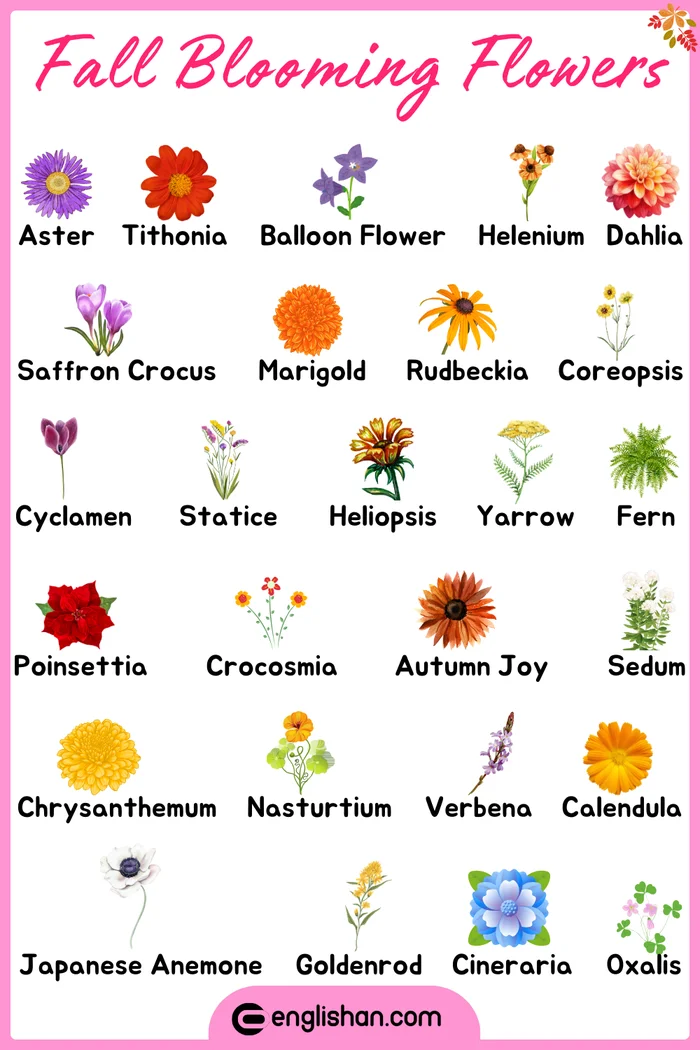
Winter Blooming Flowers
Camellia
Camellias are stunning winter flowers with glossy petals that brighten up gardens during the colder months. They are known for their elegant blooms that come in shades of pink, red, and white. These flowers names are synonymous with winter beauty and elegance.
- Color: Pink, red, white
- Fragrance: Mild
- Blooming Season: Winter
- Maintenance Level: Moderate
- Lifespan: Perennial
Hellebore
Hellebores, also known as Christmas roses, are hardy winter flowers that bloom in a variety of colors. They are perfect for adding color to winter gardens when most other plants are dormant.
- Color: White, pink, purple, green
- Fragrance: Mild
- Blooming Season: Winter
- Maintenance Level: Low
- Lifespan: Perennial
Christmas Cactus
Christmas Cactus is a popular indoor plant that blooms with vibrant, tubular flowers in the winter. It’s known for its ease of care and ability to bloom around the holiday season.
- Color: Pink, red, white, orange
- Fragrance: None
- Blooming Season: Winter
- Maintenance Level: Low
- Lifespan: Perennial
Winter Jasmine
Winter Jasmine is a hardy vine that produces bright yellow flowers in the cold winter months. It’s known for its cheerful blooms that stand out against the bare branches of winter.
- Color: Yellow
- Fragrance: Mild
- Blooming Season: Winter
- Maintenance Level: Low
- Lifespan: Perennial
Cyclamen
Cyclamens are winter flowers with heart-shaped leaves and bright, butterfly-like blooms. They are often grown indoors or in shaded garden beds, bringing vibrant color to winter landscapes. These flowers names are often associated with indoor winter beauty.
- Color: Pink, red, white
- Fragrance: Mild
- Blooming Season: Winter
- Maintenance Level: Moderate
- Lifespan: Perennial
Snowdrop
Snowdrops are delicate white flowers that bloom as early as January, signaling the end of winter. Their small, bell-shaped flowers are a symbol of hope and purity.
- Color: White
- Fragrance: Mild
- Blooming Season: Late Winter
- Maintenance Level: Low
- Lifespan: Perennial
Heather
Heathers are hardy shrubs that produce small, bell-shaped flowers in winter. They add a splash of color to gardens during the colder months and are known for their resilience in tough conditions.
- Color: Purple, pink, white
- Fragrance: Mild
- Blooming Season: Winter
- Maintenance Level: Low
- Lifespan: Perennial
Paperwhite Narcissus
Paperwhite Narcissus are fragrant winter flowers that bloom indoors. They are often forced to bloom in pots during the winter months, filling homes with their sweet scent.
- Color: White
- Fragrance: Strong
- Blooming Season: Winter
- Maintenance Level: Low
- Lifespan: Perennial
Mahonia
Mahonias are evergreen shrubs that produce clusters of yellow flowers in winter. They are known for their spiky leaves and bright blooms that attract pollinators even in the coldest months.
- Color: Yellow
- Fragrance: Mild
- Blooming Season: Winter
- Maintenance Level: Low
- Lifespan: Perennial
Winter Aconite
Winter Aconites are small, bright yellow flowers that bloom in late winter. They are among the first flowers to emerge as the snow melts, bringing early color to gardens. These flowers names are often associated with the first signs of spring.
- Color: Yellow
- Fragrance: Mild
- Blooming Season: Late Winter
- Maintenance Level: Low
- Lifespan: Perennial
Witch Hazel
Witch Hazels are unique winter flowers with spidery, fragrant blooms. They are known for their vibrant yellow or red flowers that appear on bare branches, making them a standout in winter gardens.
- Color: Yellow, red
- Fragrance: Strong
- Blooming Season: Winter
- Maintenance Level: Low
- Lifespan: Perennial
Winter Honeysuckle
Winter Honeysuckles are fragrant shrubs that bloom in the cold months, producing small, creamy-white flowers. Their strong scent is a welcome surprise in the winter garden.
- Color: White
- Fragrance: Strong
- Blooming Season: Winter
- Maintenance Level: Low
- Lifespan: Perennial
Algerian Iris
Algerian Irises are winter-blooming flowers that bring a touch of color to the garden with their blue or violet petals. They are among the few irises that bloom in winter, adding elegance to the cold season.
- Color: Blue, violet
- Fragrance: Mild
- Blooming Season: Winter
- Maintenance Level: Low
- Lifespan: Perennial
Cornelian Cherry
Cornelian Cherries are small trees that produce clusters of bright yellow flowers in late winter. They are often grown for their early blooms, which appear before the leaves, adding a pop of color to the winter landscape.
- Color: Yellow
- Fragrance: Mild
- Blooming Season: Late Winter
- Maintenance Level: Low
- Lifespan: Perennial
Winter Flowers Names with Pictures

Multiple Seasons Flowers
Aloe Vera
Aloe Vera is a succulent known for its healing properties and blooms year-round with tall flower spikes.
- Color: Yellow, orange
- Fragrance: Mild
- Blooming Season: Year-Round
- Maintenance Level: Low
- Lifespan: Perennial
Fern
Ferns are lush, green plants that thrive year-round, adding texture to gardens and homes.
- Color: Green
- Fragrance: None
- Blooming Season: Year-Round
- Maintenance Level: Low
- Lifespan: Perennial
Geranium
Geraniums are versatile plants that bloom all year, perfect for both garden beds and containers.
- Color: Red, pink, white, purple
- Fragrance: Mild
- Blooming Season: Year-Round
- Maintenance Level: Moderate
- Lifespan: Perennial (often treated as annual)
Crown Imperial
Crown Imperials are striking plants that bloom with bell-shaped flowers and thrive through multiple seasons.
- Color: Red, yellow, orange
- Fragrance: Strong
- Blooming Season: Spring to Fall
- Maintenance Level: Moderate
- Lifespan: Perennial
Wisteria
Wisterias are climbing plants that produce cascading flowers in spring, with sporadic blooms throughout the year.
- Color: Purple, white, blue
- Fragrance: Mild
- Blooming Season: Spring and Sporadically Year-Round
- Maintenance Level: Moderate
- Lifespan: Perennial
Bottlebrush
Bottlebrushes are shrubs known for their bright, brush-like flowers that bloom multiple times a year.
- Color: Red, pink, white
- Fragrance: Mild
- Blooming Season: Year-Round
- Maintenance Level: Low
- Lifespan: Perennial
Cockscomb
Cockscombs are unique, crested flowers that bloom across multiple seasons, adding texture and color to gardens.
- Color: Red, yellow, pink
- Fragrance: None
- Blooming Season: Year-Round
- Maintenance Level: Low
- Lifespan: Annual or Perennial (depending on variety)
Lamium
Lamiums are hardy ground covers that bloom year-round with small, delicate flowers in various colors.
- Color: Pink, purple, white
- Fragrance: None
- Blooming Season: Year-Round
- Maintenance Level: Low
- Lifespan: Perennial
Mimosa
Mimosas are fast-growing trees that produce fluffy, pink blooms throughout the year, especially in warm climates.
- Color: Pink, yellow
- Fragrance: Mild
- Blooming Season: Year-Round
- Maintenance Level: Low
- Lifespan: Perennial
Rhododendron
Rhododendrons are large shrubs that bloom in spring and occasionally throughout the year.
- Color: Purple, pink, red, white
- Fragrance: Mild
- Blooming Season: Spring and Sporadically Year-Round
- Maintenance Level: Moderate
- Lifespan: Perennial
Bleeding Heart
Bleeding Hearts are delicate flowers that bloom in spring and may re-bloom in cooler seasons.
- Color: Pink, white
- Fragrance: Mild
- Blooming Season: Spring and Sporadically Year-Round
- Maintenance Level: Moderate
- Lifespan: Perennial
Echinacea
Echinaceas are robust flowers that bloom primarily in summer but can extend their display into other seasons.
- Color: Purple, pink, white
- Fragrance: Mild
- Blooming Season: Summer and Sporadically Year-Round
- Maintenance Level: Low
- Lifespan: Perennial
Freesia
Freesias are fragrant flowers that bloom multiple times a year, making them a garden favorite.
- Color: White, yellow, pink, purple
- Fragrance: Strong
- Blooming Season: Year-Round
- Maintenance Level: Moderate
- Lifespan: Perennial
Rhodora
Rhodoras are hardy shrubs that bloom in spring and may re-bloom in other seasons.
- Color: Pink, purple
- Fragrance: Mild
- Blooming Season: Spring and Sporadically Year-Round
- Maintenance Level: Low
- Lifespan: Perennial
Yucca
Yuccas are drought-tolerant plants that produce tall flower spikes throughout the year, especially in dry climates.
- Color: White
- Fragrance: Mild
- Blooming Season: Year-Round
- Maintenance Level: Low
- Lifespan: Perennial
Gloxinia
Gloxinias are tropical plants that bloom multiple times a year with large, bell-shaped flowers.
- Color: Pink, red, purple, white
- Fragrance: Mild
- Blooming Season: Year-Round
- Lifespan: Perennial
Oxeye Daisy
Oxeye Daisies are cheerful flowers that bloom throughout the growing season, brightening up gardens with their classic look.
- Color: White with yellow center
- Fragrance: Mild
- Blooming Season: Spring to Fall
- Lifespan: Perennial
Catmint
Catmints are fragrant perennials that bloom continuously through the growing season, attracting pollinators.
- Color: Blue, purple
- Fragrance: Strong
- Blooming Season: Spring to Fall
- Lifespan: Perennial
Fritillaria
Fritillarias are unique, bell-shaped flowers that bloom in spring and occasionally in other seasons.
- Color: Yellow, orange, purple
- Fragrance: Mild
- Blooming Season: Spring and Sporadically Year-Round
- Lifespan: Perennial
Lilium
Lilies are elegant flowers that bloom in summer and can re-bloom in other seasons.
- Color: White, pink, orange, yellow
- Fragrance: Strong
- Blooming Season: Summer and Sporadically Year-Round
- Lifespan: Perennial
Love-Lies-Bleeding
Love-Lies-Bleeding is a dramatic plant with cascading red flowers that bloom through multiple seasons.
- Color: Red, green
- Fragrance: None
- Blooming Season: Summer to Fall
- Maintenance Level: Low
- Lifespan: Annual or Perennial (depending on variety)
Spider Flower
Spider Flowers are tall plants with spidery blooms that appear from spring through fall.
- Color: Pink, white, purple
- Fragrance: Mild
- Blooming Season: Spring to Fall
- Lifespan: Annual
Peacock Flower
Peacock Flowers are tropical plants that bloom year-round with bright, showy flowers.
- Color: Red, yellow, orange
- Fragrance: Mild
- Blooming Season: Year-Round
- Lifespan: Perennial
Dutchman’s Breeches
Dutchman’s Breeches are unique, spring-blooming flowers that may bloom again in cooler seasons.
- Color: White, yellow
- Fragrance: Mild
- Blooming Season: Spring and Sporadically Year-Round
- Lifespan: Perennial
Bluebell
Bluebells are enchanting flowers that bloom in spring and may re-bloom in other seasons.
- Color: Blue, purple
- Fragrance: Sweet
- Blooming Season: Spring and Sporadically Year-Round
- Maintenance Level: Low
- Lifespan: Perennial
Plumeria
Plumerias are tropical flowers known for their fragrant blooms that appear year-round, especially in warm climates.
- Color: White, yellow, pink, red
- Fragrance: Strong
- Blooming Season: Year-Round
- Lifespan: Perennial
Statice
Statices are long-lasting flowers that bloom in summer and may continue into fall.
- Color: Purple, blue, white, pink
- Fragrance: Mild
- Blooming Season: Summer to Fall
- Lifespan: Perennial
Multiple Seasons Flowers with Pictures

Flowers Names Infographics
FAQs
Here is a list of 20 flower names:
1. Rose
2. Lotus
3. Sunflower
4. Jasmine
5. Lily
6. Tulip
7. Daisy
8. Marigold
9. Orchid
10. Hibiscus
11. Lavender
12. Chrysanthemum
13. Daffodil
14. Poppy
15. Peony
16. Dahlia
17. Carnation
18. Bougainvillea
19. Bluebell
20. Iris
Here are 12 common flower names:
1. Rose
2. Sunflower
3. Jasmine
4. Lily
5. Tulip
6. Daisy
7. Marigold
8. Orchid
9. Hibiscus
10. Lavender
11. Daffodil
12. Lotus
The English name for the flower “Champa” is Plumeria. It is also commonly known as Frangipani.
The Chameli flower in English is called Jasmine.
The Chap tree in English is known as the Cork tree. Its scientific name is Millingtonia hortensis, and it is also sometimes referred to as the Tree Jasmine due to its fragrant flowers.
You May Also Like

